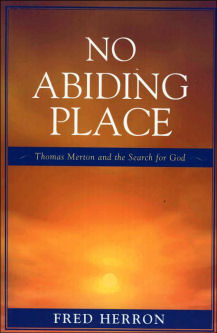
|
Posted August 30, 2005
Book: No Abiding Place: Thomas Merton and the Search for God Author: Fred Herron University Press of America, Lanham, MD, pp. 118 An Excerpt from the Jacket:
Part one of the book describes this profound paradigm shift and locates Merton’s developing thought within that landscape. It places Merton’s thought within the larger framework of the Catholic imagination as described by David Tracy, Andrew Greeley, and Thomas Groome. The landmark research of Robert Wuthnow of Princeton University concerning the nature of contemporary spiritual seeking provides a framework that helps to identify Merton’s continuing relevance for the study of spirituality. Parts two and three discuss Merton’s lasting importance for contemporary spirituality. An Excerpt from the Book: Merton happily pointed to the growing awareness of the church as being, first of all, not a hierarchy but the community of God’s people. On June 11, 1962 he wrote to a woman who had just become a Catholic, that she should have a sense that “the Catholic laity are an important, very important part of the people of God. The Church is not just an institution for the benefit of priests and nuns, with lay people around to fill in the background.” Merton clearly saw that the church structures were subordinate to the call of love in the Covenant. He argued that the organizational structures of the church, while having their own importance, are not ends in themselves; they exist for the sake of love, and life. That is, “they exist to safeguard the freedom of the Spirit within the framework of earthly society.” Ultimately, for Merton, the true end of the Church is the transformation of its members and of society and the consecration of all life to God. Administrators and teachers who grapple daily with each new wave of bad news and the shocks which these bring to their own lives, as well as the lives of colleagues, parents and students, are challenged to recall the rich imaginative tradition that is at the heart of the Catholic story. A profound sacramental awareness, a belief that ultimate reality is too big to be contained in any one moment but may instead be hinted at in moments of exploding grace, is more substantial and enduring than the shifting moments and structures of each daily crisis. Like Thomas Merton in a generation slowly fading into the mists of time, we too look for some light and direction in these matters. Writing in 1962, the year in which Vatican Council II began, he remarked that the task ahead would not be an easy one. You may, at times, have the feeling “that you are just scrambling up the gangplank into the ark, and be prepared at times to wonder if the ark itself is going to leak. Ultimately, our trust has to be in God,” the God of the Convenant. At this critical moment in the life of the church we need to be passionate in our love for the tradition that nourished us and that calls us to look critically at the affairs of the day. We need to be confident in the presence of the Spirit calling us to renew the face of the earth and the face of our parishes and schools in this moment of opportunity. Ultimately, we need to be assured that this is our task to undertake and our cross to bear. This is not always evident in the contemporary ecclesial setting. There are places still where Merton’s rhinoceros can be found. Belgian Cardinal Jan Schotte, responding to questions regarding a lack of accountability during the Synod of bishops in October 2001, is reported to have responded that bishops are “accountable to no one but the Holy Father, and the Holy Father is accountable to no one but Jesus.” This is what Merton had in mind when he wrote to Dorothy Day in 1967: “But what is a Church but a community in which truth is shared, not a monopoly that disperses it from top down. Light travels on a two-way street in our Church, or I hope it does.” The challenge for administrators and all who share in the vocation of Catholic education as we face the present crisis is to remember, as Merton did, that the heart of our religion is love and “whatever may happen, let us remember that persons are more important than opinions.” We are called to search for common ground where our communities can meet, “. . .to be bridge-builder(s) for everybody.” Table of Contents: Part One: Merton and a New Paradigm No abiding place: Thomas Merton and the search for a new paradigm Thomas Merton and the retrieval of the Catholic imagination Thomas Merton and a spirituality for millennials Part Two: Merton and young people To be who you really are: Thomas Merton’s appeal to today’s students The present festival: Thomas Merton and the adolescent search for God Love is my name: On-going integration and adolescent spiritual growth Part Three: Merton and the Search for God The core of self-discovery: fundamental option and the search for the true self Light travels on a two-way street: Thomas Merton and Catholic Schools in the present crisis |
|
